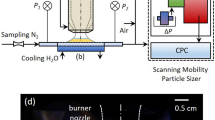Abstract
The actual work deals with the present state of research on flame ions, polyaromatic hydrocarbons, nanotubes, fullerenes, and soot particles in premixed flames. Experimental arrangements for detection and quantitative investigation of flame ions are presented. In addition, the influence of ions on flame chemistry and on formation of carbon particles under non-sooting and sooting conditions is discussed. The study also focuses on the formation pathway from flat polyatomic hydrocarbons to fullerenes, nanotubes, and soot particles. In this connection, the features of arched “aromers,” which are high reactive metastable species and leading candidates for soot precursors and fullerene formation, are reported. These aromers seem to be a kind of “switch” capable of producing either fullerenes or soot particles, depending on the reaction conditions. At lower flame temperatures and a high number density of small unsaturated hydrocarbons, bimolecular reactions are favored, and the formation of soot particles exceeds that of fullerenes. It is also shown how the further growth of soot particles can be described, namely, by soot mass growth and by coagulation processes in strong sooting flames. Typical values for soot volume fractions and particle diameters under various reaction conditions are given.
Similar content being viewed by others
References
Q. L. Zhang, S. L. O’Brien, J. R. Heath, et al., “Reactivity of large carbon clusters: spheroidal carbon shells and their possible relevance to the formation and morphology of soot,” J. Phys. Chem., 90, 525 (1986).
F. Haber, “Ueber die Stickoxydbildung bei der Kohlenoxydverbrennung,” Z. Phys. Chem., 337–388 (1909).
Ph. Gerhardt, S. Löffler, and K. H. Homann, “Polyhedral carbon ions in hydrocarbon flames,” Chem. Phys. Lett., 137, 306 (1987).
S. Löffler, Ph. Löffler, P. Weilmuenster, and K. H. Homann, “Growth of large ionic polycyclic aromatic hydrocarbons in sooting flames,” in: H. Bockhorn (ed.), Soot Formation in Combustion, Springer Verlag (1992), pp. 66–82.
J. B. Howard, J. T. Mc Kinnon, Y. Makarovsky, et al., “Fullerenes C60 and C70 in flames,” Nature, 352, 139 (1991).
K. H. Homann, “Fulleren-und Russbildung-Wege zu grossen Teilchen in Flammen,” Angew. Chem., 110, 2572–2590 (1998).
P. Weilmuenster, A. Keller, and K. H. Homann, “Large molecules, radicals, ions, and small soot particles in fuel-rich hydrocarbon flames. Part I: Positive ions of polycyclic aromatic hydrocarbons (PAH) in low-pressure premixed flames of acetylene and oxygen,” Combust. Flame, 16, 63–83 (1999).
Th. Baum, “Positive Ionen in 1.3-Butadien-Niederdruckflammen,” Ph. D. Thesis, Darmstadt (1996).
R. Vander Wal, “Flame synthesis of substrate-supported metal-catalyzed carbon nanotubes,” Chem. Phys. Lett., 324, 217–223 (2000).
W. Merchan-Merchan, A. V. Saveliev, L. A. Kennedy, and A. A. Fridman, “Formation of carbon nanotubes in counter-flow oxy-methane diffusion flames without catalysts,” Chem. Phys. Lett., 354, 20–24 (2002).
J. B. Howard, “Fullerenes formation in flames, in: Proc. of the 24th Symp. (Int.) on Combustion, The Combustion Inst., Pittsburgh (1992), pp. 933–946.
H. Böhm, D. Hesse, H. Jander, et al., “The influence of pressure and temperature on soot formation in premixed flames,” in: Proc. of the 22nd Symp. (Int.) on Combustion, The Combustion Inst., Pittsburgh (1988), pp. 403–411.
H. Böhm, Chr. Feldermann, Th. Heidermann, et al., “Soot formation in premixed C2H4-air flames for pressure up to 100 atm,” in: 24th Symp. (Int.) on Combustion, The Combustion Inst., Pittsburgh (1992), pp. 991–998.
R. A. Dobbins and C. M. Megaridis, “Morphology of flame-generated soot as determined by thermophoretic sampling,” Appl. Opt., 30, No. 33, 4747 (1991).
Ue. Oe. Koeylue, “Quantitative analysis of in situ optical diagnostics for inferring particle/aggregate parameters in flames: Implications for soot surface growth and total emissivity,” Combust. Flame, 109, 488–500 (1997).
W. Stahlberg, “Aggregatenbildung der Russteilchen in Kohlenwassersto./Luftflammen in einem Druckbereich von ein bis fuenf atm,” Ph. D. Thesis, Göttingen (2004).
W. H. Dalzell and A. F. Sarofim, “Optical constants of soot and their application to heat flux calculations,” Trans. ASME, J. Heat Transfer, 91, 100 (1969).
A. G. Gaydon and H. G. Wolfhard, Flames: Their Structure, Radiation, and Temperature, Chapman and Hall, New York (1978).
Ph. Gerhardt, S. Löffler, and K. H. Homann, “The formation of polyhedral carbon ions in fuel-rich acetylene and benzene flames,” in: Proc. of the 22nd Symp. (Int.) on Combustion, The Combustion Inst., Pittsburgh (1988), pp. 395–401.
A. Keller, R. Kovacs, and K. H. Homann, “Large molecules, ions, radicals and small soot particles in fuel-rich hydrocarbon flames,” Phys. Chem. Chem. Phys., 2, 1667–1675 (2000).
M. J. Height, J. B. Howard, and J. W. Tester, “Flame synthesis of single-walled carbon nanotubes,” in: Proc. of the 30 th Symp. (Int.) on Combustion, The Combust. Inst., Pittsburgh (2004), pp. 2537–2543.
S. Iijima, “The 60-carbon cluster has been revealed!” J. Phys. Chem., 91, 3466 (1987).
W. Kraetschmer, L. D. Lamb, K. Fostiropoulos, and D. Huffmann, “Solid C60: A new form of carbon,” Nature, 347, 354 (1990).
M. S. Dresselhaus, G. Dresselhaus, and Ph. Avouris (eds.), Carbon Nanotubes, Springer Verlag (2001).
M. Boenig, Chr. Feldermann, H. Jander, et al., “Soot formation in premixed C2H4 flat flames at elevated pressure,” in: 23nd Symp. (Int.) on Combustion, The Combustion Inst., Pittsburgh (1990), pp. 1581–1587.
Author information
Authors and Affiliations
Additional information
__________
Translated from Fizika Goreniya i Vzryva, Vol. 42, No. 6, pp. 82–88, November–December, 2006.
Rights and permissions
About this article
Cite this article
Jander, H., Wagner, H.G. Formation of flame ions, clusters, nanotubes, and soot in hydrocarbon flames. Combust Explos Shock Waves 42, 696–701 (2006). https://doi.org/10.1007/s10573-006-0103-x
Received:
Issue Date:
DOI: https://doi.org/10.1007/s10573-006-0103-x




